11 phishing email subject lines your employees need to recognize [Updated 2022]
By now, we’ve all probably received an enticing email from a long-lost relative promising untold riches and wealth. In fact, there might be a few sitting in your spam box as you read this. That’s because the game is up for phishers using lures like inheritance money.
These days, savvy phishers have buried the dead relative scheme in favor of urgent business messages or cybersecurity warnings. According to a recent ZDNet article, “The most common subject lines used in phishing emails targeting businesses show how cybercriminals are exploiting urgency, personalisation and pressure in order to trick victims into clicking on malicious links, downloading malware or otherwise surrendering confidential or sensitive corporate information.”
In other words, criminals create a false sense of urgency to trick your staff into clicking before they think. And this strategy works: 53% of organizations reported a phishing-related breach, more than any other cause. Fortunately, there are tactics you can take to empower your employees to resist phishing attempts. Teaching them how to spot the subject line of a phishing email is one of the most effective security awareness strategies you can share.

Two year's worth of NIST-aligned training
Deliver a comprehensive security awareness program using this series' 1- or 2-year program plans.
Let’s take a look at some of the top phishing email subject lines your employees need to recognize:
1. Immediate password check required
This subject line is insidious because it taps into a commonplace occurrence in offices across the world: expired passwords. The average employee is juggling dozens of passwords, some of which have set expiration dates. So when an email pops up warning them that their password needs to be updated, it’s disguising itself as a friendly reminder. However, it’s anything but.
Clicking on the link will lead to a spoof site that harvests your employee’s log-in credentials. Just like that, the hacker has access to the account! And since 1 out of every 8 employees will accidentally share information on a phishing site, this poses an excellent training opportunity.
Keep an eye out for some common variations of this email subject line, including:
- Change of Password Required Immediately
- Office 365: Change Your Password Immediately
- Slack: Password Reset for Account
2. Billing information is out of date
Cybercriminals have been known to disguise themselves as third-party vendors to gain access to a company’s financial resources. One of these strategies involves sending an email that alleges an account’s billing information needs to be updated. An unsuspecting employee may follow the link to a spoof site and enter the billing information, therefore putting corporate credit card or bank account numbers directly into the hands of criminals.
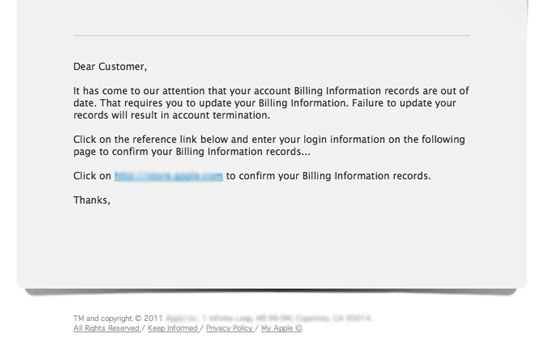
(Source: Canadian Bankers Association)
3. Payroll has been delayed
Payroll departments should run like well-oiled machines, which is why a perceived payroll delay could have disheartened employees rushing to learn more about the situation. Their quest for an explanation will lead them to a phishing website that collects their credentials and leaves the actual payroll department none the wiser.
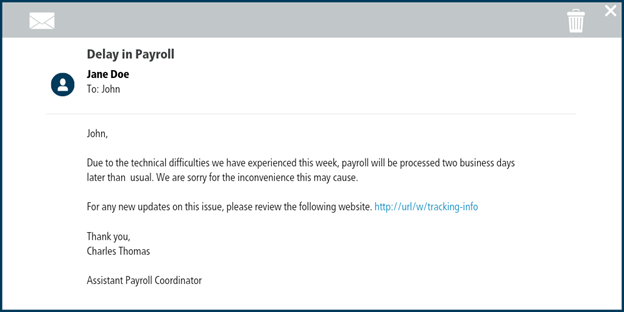
(Source: Center for Internet Security)
4. Your meeting attendees are waiting!
It’s human nature that we don’t like to keep people waiting. If you’ve ever been stuck in traffic minutes before a big meeting is about to begin, then you’re familiar with that sense of anxious dread.
Hackers have recreated that nightmare situation in your inbox. A subject line about meeting attendees will probably have you dashing to the link to the “meeting room,” only to get hit with a piece of malware. Watch Infosec's Keatron Evans' demo of how Zoom is being exploited for phishing attacks to see this attack in action.
5. Office reopening schedule
Phishing emails may trick staff by disguising their contents as something important. After all, you're much less likely to scroll past an email if it sounds essential to your job. That’s why it’s increasingly common for scammers to use lofty-sounding subject lines. In the wake of COVID-19, this might include an office re-opening schedule or vaccination policy.
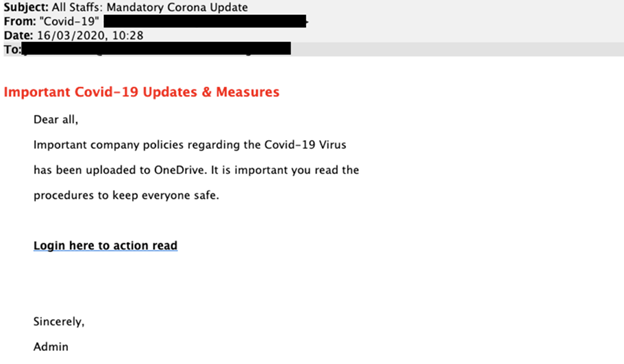
(Source: Risk Management Monitor)
6. Confidential information about COVID-19
Ooh, what is it? Secret vaccination info? A list of top-secret test sites? People like secrets — they make us feel exclusive and important. Plus, if the email promises to fill us in on something life-changing like COVID-19, we feel additional pressure to click on it.
If you haven’t already, it may behoove you to issue a warning to your employees about COVID-19 phishing emails. They saw a 30,000 percent increase during 2020, and continue to be effective as new COVID strains stay in the news.
7. Updated vacation policy
Clever attackers may try to give their emails an air of legitimacy by disguising them as business communications from Human Resources. One of the most commonly clicked attacks is about updated employee policies regarding vacation time or other benefits.
Keep in mind that HR resources are often only accessible through an employee portal. That means hackers may try to snatch your employees’ login credentials via a spoof site or portal.
8. Employee raises
Any mention of salary is sure to grab your employees’ attention, from annual raises to holiday bonuses and everything in between. One particular scam appears to come from the company HR department regarding a raise. Linked or attached is a spreadsheet claiming to detail the employee’s wage increase. Unfortunately, the link leads to a spoof login page that harvests the employee’s credentials. The only one walking away with a raise is the scammer!
This attack has been in the headlines recently. The website hosting company GoDaddy found itself the recipient of unwanted news coverage when it sent a fake phishing email to its employees, saying that they’d received a $600 Christmas bonus (which did not exist). The exercise raised many questions about the ethical considerations of leading one’s employees with such baldly emotional material to test their security awareness.
9. Dropbox: Document shared with you
Many companies use collaborative tools like Dropbox so that colleagues can share media like documents and images in real-time. Unfortunately, file attachments are a common vector for malware. And of users who receive infected attachments, 12% will click on them. Hackers will attempt to spread infected files by spoofing a Dropbox email and tricking their victims into downloading the document.
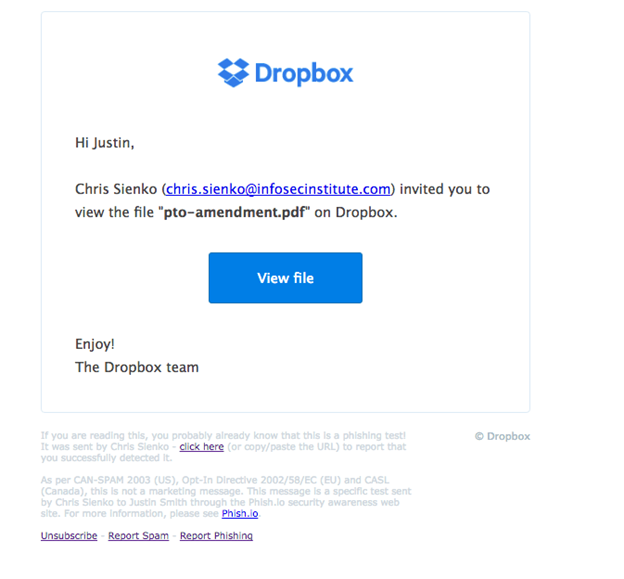
(Source: Infosec Resources)
10. Attention: unusual account activity detected!
ALERT! DANGER! ACT IMMEDIATELY! That’s what this subject line screams, and it will have your employees scrambling to open the email for more details. Once they arrive at the destination, they’ll be asked to enter their credentials and the real security breach will begin.
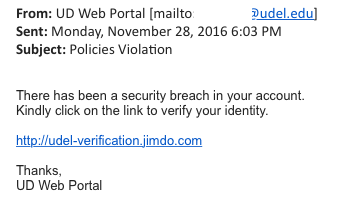
(Source: University of Delaware)
11. Earn money working from home
In today’s gig economy, many people like to balance lucrative side hustles with their main line of work. Hackers like to prey on this by pitching fake work-from-home jobs and freelance gigs. Depending on how elaborate the scheme is, these hackers could steal anything from sensitive personal information (like Social Security numbers and bank accounts) to actual money by claiming it covers onboarding supplies like laptops and tablets.
See Infosec IQ in action
Keep your employees out of hot water with phishing training
Phishing emails are so effective because they have a pernicious way of catching people off guard. That means the more your employees know about phishing, the less likely they are to fall for potential attacks.
Cybersecurity training workshops and simulated phishing attacks are both excellent ways to keep your staff from taking the bait from a phisher. And when your employees do stumble across a phishing scam, encourage them to report it — even if they accidentally clicked on it. Only 3% of employees report phishing emails, but if that number were higher, there’d be much fewer dangerous phish lurking in your company’s network.
Have you or your employees recently received a phishing email? Let us know what the subject line was in the comments!
Sources
- These are the 12 most common phishing email subject lines cyber criminals use to fool you, ZDNet
- Top 10 Phishing Attack Statistics That Should Scare You, Clearedin
- Staggering Phishing Statistics in 2020, Security Boulevard
- Fraudsters Use Salary Increase Scam to Steal Employees’ Credentials, The State of Security
- The Lesson of GoDaddy’s Fake Christmas Bonus Email Phishing Test, DataDrivenInvestor







